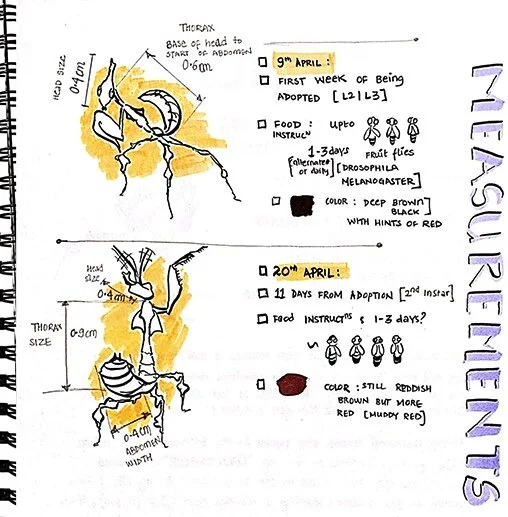“Nature shows us only the tail of the lion. But there is no doubt in my mind that the lion belongs with it even if he cannot reveal himself to the eye all at once because of his huge dimension.”
- Albert Einstein
John Muir Laws aka. Jack Laws, our mentor, often tells us that the biggest revelation of nature lies just beyond the point where we stop asking questions. The infinite loop of curiosity.
I have been nature journaling since the past two years and have gone through many different phases during this time - desperate to make my drawings pretty, struggling with watercolor, stressing over my questions being too “basic”, not knowing enough. Phew! Those were some stressful times. But, something changed over time which made journaling a VERY fun experience for me.
In retrospect, I learnt that nature journaling is like solving a 10,000 piece puzzle. When you are gathering the first few pieces, you have no idea what to do with them. You struggle for the first few days, and then YAY! You make your first connection and learn to enjoy the process. This gives you hope and you keep going. The disjoint sets of information eventually start to come together to form a bigger picture. Satisfaction!
I learnt that simpler questions about our observations in nature lead to bigger, more complicated questions, discovering the answers to those questions leads to more questions. You slowly learn to ask different questions and to ask questions differently over time, and before you know it, you have signed yourself up for a lifetime of puzzle solving fun.
“Gargi, you lie. There are only so many questions you can ask about something”. Let me walk you through our latest nature journaling obsession to demonstrate how fun it can be to get stuck in the “infinite loop of curiosity”.
My husband (Akshay Mahajan) and I adopted a ghost mantis (Mithun) in April 2020, our first pet ever! Never having taken up the responsibility of keeping an insect alive before, we started reading about the care and feeding instructions and noting down the information in our journal. We started journaling about insect anatomy, leg anatomy, took measurements, zoomed in on all parts and noted our observations on paper, counted how many flies it ate each day etc.
At this point, we had no clue what observations were important to note, what the right questions to ask were, what measurements were important to take, why we were doing this and where it would take us. We were mainly just capturing descriptive insights.
Then we started seeing some unusual patterns. Our mantis rejected food for the first time, stayed inverted all day long and did not move from its position for many hours. We were worried that we did something wrong during our caretaking but then it molted after 2 days. AHA! Could the change in behavior be related to the molting process? Will we see the same patterns again during the next molt? How much bigger did Mithun get this time? Will it need more food now? What parts look different than they did before molting? Should we expect to see any new behaviors based on the new appearance? ……..and the fun began!
We decided to journal about the molted exoskeleton next. What good could come out of studying a discarded exoskeleton, right? This is the part where we stop sleeping peacefully for the next couple days out of excitement. We could see the eye cover, antennae, legs etc. on the exoskeleton. Does that mean that the antennae also grow bigger over time? (We noticed the presence of antennae on the exoskeleton in a different picture later) Why? How does the fat abdomen squeeze out of a tiny rupture we saw on the exoskeleton? How do the fat portions of the leg come out of the thinner portions of the exoskeleton? Did it stop eating to get thinner? Was there a chemical reaction taking place on the inside which made it not want to eat? So many unanswered questions. Now we had a version 2 of the important measurements to keep a track of. Things started to make sense and we never may have arrived at these questions if we did not track our clueless observations and questions in the first place. We started to think about its digestive system, nervous system, circulatory system etc.
Finally, the most rewarding and addictive part of this care taking process has been experiments! There are not enough resources on the internet to give all the answers, so how do you get the answers to keep the curiosity cycle going? EXPERIMENTS! Akshay and I are currently brainstorming on what attributes we can test against to understand what triggers a Mantis to attack vs ignore a “prey” item. We even went overboard and wrote up a computer program to simulate various prey scenarios (Akshay) and built a database system (Gargi) to capture the Mantis’ response for further analysis. BRAINSTORMING IS THE BEST!
Here are some of Akshay’s work-in-progress pages:
The 2018 version of me never would have thought that I would be able to hold an insect in my hand and study it someday. (Thank you Stephanie Dole). The 2020 version of me is now curious about what the 2060 version of me would look like.
I hope this made you want to go and start a pet journal (dog, cat, mould on an orange, flower on your plant etc. all count) as your next project. Try recording slow-motion videos, timelapses, imagining cross sections, studying zoom-in views etc. to help you learn more about your pet.
Happy Journaling!
You can find more of Gargi’s journal pages on her Instagram profile @inkuisitive.being.










